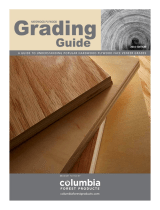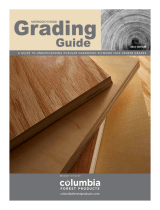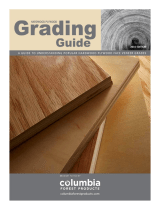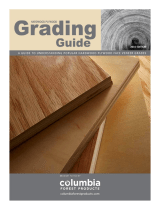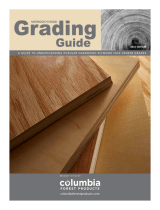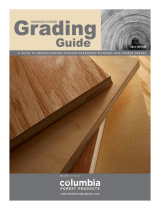Page is loading ...

P38-GK021-81001001

Travelogue with Mini Beest
Cooperation/Theo Jansen Media Force Ltd.
Photograph/Loek van der Klis
Text/Gakken Editor Team
Theo Jansen, the inventor of the Strandbeest, a new type of kinetic art, is a Dutch artist.
How has the landscape and the climate of the Netherlands inuenced Jansen in his artwork?
We traveled to meet Jansen with our mini beest.
Theo Jansen has his workshop situated
on the hill of Ypenburg, just outside of
Delft in the southern Netherlands. In
the picture, behind him is his newest
creation, "Siamesis".
Contents:
4
A Netherlands Travelogue with Mini Beest
12
Special Interview
The World of Theo Jansen
18
Tracing the Evolution of the Strandbeest
28
How to Assemble and Use the Mini Strandbeest
At the hill of Ypenburg
1 2
Netherlands
Scheveningen
Amsterdam
Germany
France
Rotterdam
Ypenburg
A Netherlands

Jansen picked up the mini beest,
turned the wings by hand, and
checked the functions of the legs.
He was absorbed in checking out
this miniature beest. We were so
relieved to hear the master's
comment, "Good job!".
3 4
At the workshop of the Strandbeests
Jansen's workshop is located on the hill of Ypenburg. In the Netherlands,
where the land is mostly at and low in altitude, buildings on the hills
stand out. Jansen's workshop is quite famous among the neighborhood.
He was presented this hillside property by the town as an art grant. The
Netherlands traditionally holds a deeper understanding and oers
support for artists.

5 6
At the beach in Scheveningen
From Jansen's workshop in Ypenburg to the beach
in Scheveningen, it takes about 20 minutes by car.
The Strandbeests are brought from the workshop
to this beach to take their rst steps as living
creatures. The perfect wind gives life to the beests.

The windmills are symbolic to the Netherlands.
Historically, people have been utilizing the wind power
in their lives in the Netherlands. The red tent in this
photo is owned by an engineering team of Delft
University of Technology where Jansen has graduated.
7 8
In the suburbs of Amsterdam
Many art installations and exhibits are seen around
the neighborhoods and communities in the cities and
towns of the Netherlands. One of the examples is the
strandbeest "Rhinoceros". The Rhinoceros is now
retired and stands quietly showing o its graceful 5m
tall body. In a nearby park, we found a tent lab that is
an experimental living space run by wind power.
At the end of our trip, we were very inspired by the
people's appreciation of the art and their interests
and support for environmental preservation.

How this creator
made the beest.
9 10
What is Theo Jansen's
strandbeest?
Special Interview
Everything began with pipes
The World of Theo Jansen
A Strandbeest is a
creature made of plastic
pipes and is powered
by wind. It is almost a
living creature. The
picture on the right
shows a leg that Jansen
constructed based on
the 13 holy numbers,
ratios between each
length of pipe. The 13
holy numbers are the
keys to the life like walk
of the beests. Jansen
has characterized all the
generations of his
strandbeests, just as the
evolution of any other
biological organisms.
He also calls a single
structural unit, a cell.
various special
shape parts.
Plastic pipes sold
at consumer
construction
supply stores.
Pipe supplies in
Jansen's storage.
Among various types of kinetic art, Theo Jansen's strandbeests
are outstanding in their structures and their remarkable
motions. What is the ultimate goal of this genius, Theo Jansen?
We visited Jansen at his workshop in Ypsenburg, Netherlands.
Interviewer: First of all, why did you choose to use
plastic pipes for the materials?
Jansen: When I rst started making strandbeests in
1990, this type of plastic pipe was very popular. They
were easily found in stores. Some kids made blow
darts out of them. I even found them thrown in the
garbage cans. They were cheap as well. 4m length
with a 4mm diameter pipe was about 40 cents Euro.
Initially, I was purchasing the pipes at general stores in
town but later I started to acquire them from the
manufacturers directly.
Nowadays, the gray pipes are becoming more
common and taking the place of yellow pipes in the
markets everywhere. Before the yellow pipes become
unavailable, I needed to stock up my storages with
yellow pipes. I have about 12,000 of the 4m long pipes
in various diameters. That is a lifetime supply. I should
not have any trouble making more beests.
Cooperation/Theo Jansen Media Force Ltd.
Photograph/Loek van der Klis
Text/Gakken Editor Team
Jansen was born in 1948 in
Scheveningen, Netherlands.
He majored in physics at Delft
University of Technology.
Jansen started to create
strandbeests in 1990.

11 12
Skeletal structures, nerves, and cells:
Conditions inevitable for a life form....
Jansen: Some time in the last 20 years, I made my beests
using wood and steel. Those beests are satisfying work for
me but they are lacking something at the same time. I call
those years my "aair period" because my attention
deviated from my beloved yellow pipes. The yellow pipes
are the irreplaceable love of my life. I am just like Don
Quixote. I am obsessed with the yellow pipes even
though people laugh at me.
Beside yellow pipes, I use urethane tubes for the nervous
system. It distributes air as information signals to the various
parts of body. Unfortunately, urethane tubes are not
available in the consumer market. I order them directly from
the manufacturers.
Interviewer: You make pipes into specially formed parts
and call them cells. How many dierent cells do you have?
Jansen: There are about 15 cells, though some are not used
in later beests.
Interviewer: How do you dene nervous system in
strandbeests?
Jansen: Real animals transmit electrical signals through the
nervous system. I use air for signal transmission in my
beests. In each cell, there is a signal sender and signal
receiver parts. The picture above shows some of the devices
used to construct the beests' nervous systems. A series of
pistons are used to send signals through a nervous system.
A piston is made using two pipes with dierent diameters
and has a valve inside. Let's call the state "1" when the valve
is open and "0" when the valve is closed. I connect the
pistons in series using urethane tubes so that the valve
position of one piston to the next always becomes the
opposite. When air ows into the rst piston and the valve is
closed, the internal pressure rises and pushes the valve
open. As soon as the rst piston's valve opens, the second
piston's valve closes and the internal pressure starts building
until it will open that valve. This chain of actions sends binary
signals made of 0 and 1. Pistons stuck at 1 (valve stays open)
and stuck at 0 (valve stays closed) will not transmit signals.
Interviewer: How did you come up with the "holy
numbers" which determine ratios between the lengths of
leg segments?
Jansen: The walk of living creatures involves many autono-
mous movements. I examined many animals walking. The
feet of an animal move parallel to the ground and lift up at
some point. The same patterns repeat for forward and
backward walking. The picture below shows the tracing of
a foot motion.
In order to recreate this motion, I have to use linkage. I used
my ATARI computer to simulate the link mechanism that
operates just like an animal leg. I determined the ideal
ratios between the lengths of pipe segments that make up
one leg. These 13 numbers are my holy numbers.
holy numbers:
Attached a pencil at
the tip of Jansen's link
mechanism to trace
the motion of the foot.
I call this device a "liar". Let me explain how it
works. There are three liars, A, B, and C, linked
together. First, A sends a signal "1" but B trans-
mits "0". B is lying. Now, C receives the signal "0"
and makes itself the "1" state. The original
information that A sent was received by C
correctly. A lie about a lie came back to the truth.
When you look at each unit, it always sends a
false signal to the next, hence, "liar".
I believe that if I can link many liars, I can make a
system that functions as a brain. The beests'
nerves transmit binary information (0s and 1s), so
I say that the beest's nerves are a digital device,
just like a computer. There are all sorts of possi-
bilities for using this device. For example, I can
give a beest a step counter function so the beest
can know how many steps it took to get to the
beach.
Jansen shows
liars. Liars
consist of pipes,
pistons, and
valves.
Interviewer: You make your own tools to
modify plastic pipes. Is that true?
Jansen: I love to think. I am always thinking about some-
thing, so it is natural for me to come up with designs for
my own tools. Even the ones that I had to order out to be
made, I came up with the original design.
To make one strandbeest, I spend hours cutting and
modifying numerous plastic tubes. This simple work is
rather monotonous, but I don't hate simple physical work.
Cutting pipes and making rings get me into a medita-
tional state. I often come up with new ideas during these
calm times.
I sometimes hear the pipes talking to me. "I want to be
shaped this way." "You should process that way." I try to
listen to them carefully. The parts that are made accord-
ing to their opinions often become very functional and
well matched with the rest of the design.
Interviewer: Even your tools are made of the same plastic
pipes and operate using compressed air. You really are in
love with the tubes.
Jansen: This cutting tool is made of plastic tubes. I have
been using this for a very long time but never had any
trouble. Air is a great energy source. I can conveniently
vary the speed by controlling the air pressure.

13 14
Theory of Evolution
Interviewer: Why do you describe the history of the
strandbeests as the theory of evolution?
Jansen: I was greatly inuenced by Richard Dawkins'
Selsh Gene in my 20's. I wanted to evolve my beests by
expanding one idea into modied and improved versions.
Interviewer: Have you researched any species and/or
their evolutional process?
Jansen: No. On the contrary, I stayed away from
modeling the evolutionary histories of any existing
organisms. My focus has been always nding necessary
functions and abilities for the beests to adapt to the
environment and survive. For example, the newer beest
can anchor itself by hammering a peg into the sandy
ground in order to keep its body from being blown away
by gusts of wind. It also senses the tide coming in and
moves toward dry land. I have often found that some of
my beests resemble existing beach creatures or the
evolutionary process is similar to that of natural
organisms.
Interviewer: How are they going to continue evolving in
the future?
Jansen: My ultimate goal is that the strandbeests stroll,
eat, reproduce, and survive as a group on the beach
without me. I need to improve their energy system: store
air in the PET bottles and utilize it as needed. Liars need to
be modied to accommodate a more complex nervous
system. I would like the beests to behave autonomously.
Interviewer: Could you tell us about "Siamesis"?
Jansen: "Siamesis" evolved from "Umerus". It took a year
to make Siamesis, that is relatively quick work. The 200kg
beest uses 500 pipes (roughly 2km in total), 80 PET bottles,
2000 cells, and 72 legs.
Siamesis extends its wings to collect wind and stores the
compressed air for later use. It has antennae connected to
a trailing urethane tube that controls the valve by sucking
up water so that the beest navigates itself away from the
water. Siamesis is a highly evolved creature that has more
autonomous movements because of sensors. The mate-
rial of the wings is a special UV protected sheet. It is quite
costly. I am looking into other light weight, strong, and
cheaper materials.
Interviewer: I would like to ask you this question as the
conclusion of this interview. What do you do about the
beests' reproduction? The ability to reproduce is essential
to keep the species alive.
Jansen: That has always been in my thoughts. How can I
give them the ability to reproduce? I have been testing
some methods. One day I was surng the internet and
realized that people all over the world are creating all sorts
of beests using my holy numbers. I can think of this
phenomenon as a type of reproduction.
The holy numbers are open to the public through the
internet. It is a free source for everyone. It is one of my
hopes that more people in the world are inspired by my
beests and start making their own unique species
everywhere.
Interviewer: You are often compared to Leonardo da
Vinci. Do you think you are an artist or an engineer?
Jansen: I don't think of art and engineering as two
separate things. I often think about the Inuit people for
example: how their handmade primitive tools invented
by necessity are convincingly beautiful! Well thought
out and highly functional craft is artistic and beautiful by
nature. In this regard, I consider myself an artist, an
engineer, and a scientist.
If I have to pick one, I am slightly closer to an artist
because I am obsessed with the yellow pipes and the
moving objects.
(editor's words)
Theo Jansen is truly a master craftsman. He lives and
breathes his yellow pipes. His masterpieces function
awlessly, and at the same time, are powerful and beau-
tiful art.
A fossil of a retired beest with its tombstone.
Jansen is inspecting the newest beest, "Siamesis".
A handshake was exchanged
between Jansen and the
interviewer. Jansen's enormous
passion for the beests was felt
through his hand by the
interviewer.

15 16
Pre-Gluton Period
(pre 1990)
Gluton period (1990-91)
(time of tapes)
Chorda Period (1991-93)
(strap period)
Theo Jansen's philosophy, articial life form's adaptability, and their behavior.
Tracing the Evolution of
the Strandbeest
Pre-Gluton Period (pre 1990) Gluton period (1990-91) Chorda Period (1991-93) Calidum period (1993-1994) Lignatum period (1997-2001) Vaporum period (2001-2006) Cerebrum period (2006-current)Tepideem period (1994-1997)
Beest is how beast is spelled in Dutch.
It's been over two decades since Theo
Jansen conceived the idea of an articial
life form, the strandbeest. How did the
beests evolve and what kind of ideas and
philosophy supported this evolution?
Let's look at the evolutional history of the
strandbeests in 8 periods.
Simulation of articial life forms
Theo Jansen had a desire, "I would like to create a new
type of life form and observe its evolution." The rst life
Jansen created was "lineamentum", line animation on the
computer. Then "Quadrupes", a box shaped body
computer graphic animal, was born.
In the past, imaginary creatures existed only in the imagination
of a creature. Now, I created imaginary organisms on the
computer that will develop through articial evolution.
Walking animal made of pipes and
straps was born!
Chorda means string or strap. Instead of adhesive tape,
nylon straps were used to tie and join the pipes
together. As a result, a beest that is strong enough to
support its own weight and walk was born.
Previously, a leg consisted of a thigh, calf, and foot.
Now the calf and foot joined in one unit. A three part
leg evolved to a two part leg, thigh and calf.
The name chorda came from the method that beests are
put together by cords. Animaris currens vulgaris is the
rst beest that can stand and walk.
Taping together the pipes to construct the body
The rst real life creature was "Animaris Vulgaris".
Vulgaris means common or ordinary in Latin. Pipe
segments are attached by adhesive tape. The taped
joints were not strong enough for this beest to walk on
the ground.
I would like to use plastic pipes as the element to construct
beests. Just as a large part of our nature is made of protein, my
life forms are made of a single key element.
Animaris Lineamentum
The rst creation was made
on the computer. Each unit
has a very simple form, but
they are built with a
condition to accept natural
selection: Each unit will be
fatally wounded if the sharp
end of one unit scratches
the other unit.
Quadrupes
The square body moves
around on the computer by
bending and stretching the
four legs.
Animaris Vulgaris
It has 16 legs. It can move
the legs only when it lies
on its back. 0.6x2x2.5m
Legs of currens vulgaris
The right most leg
automatically takes the
position.
Animaris currens vulgaris
First walking beest. 1.4x2.1x2m

17 18
Calidum period
1993-1994
(heat period)
Pre-Gluton Period (pre 1990) Gluton period (1990-91) Chorda Period (1991-93) Calidum period (1993-1994) Lignatum period (1997-2001) Vaporum period (2001-2006) Cerebrum period (2006-current)Tepideem period (1994-1997)
Walk with apping wings by the wind
In this period, beests had evolved remarkably. Animaris Currens Ventosa (shown
in the picture) means animal running by the wind. It acquired large wings and
walked by apping its wings. A new creature activated by wind energy was
born. The new development in the manufacturing process was that heat guns
were used to bend or fuse the tubes. A variety of new parts were made by
modifying the tubes by heat gun.
Animals that can utilize wind energy to live do not need to eat food.
This type of creature can dominate sandy beaches where there is an
abundance of wind but not very much nutrients. This is a tremendous
advantage to the strandbeests since they do not need to compete with
the other animals in the nature.
Animaris sabulosa adolescens
It has four wings. The legs are
controlled by a speed changing
device. 4.5x2m
Front view of animaris currens ventosa
Animaris currens ventosa
Wind caught by the wings on the back
moves legs. 3.2x5.5x4m
(top) sketch of tail of animaris subulosa adolescens
(bottom) concept sketch of speed control mechanism

19 20
Pre-Gluton Period (pre 1990) Gluton period (1990-91) Chorda Period (1991-93) Calidum period (1993-1994) Lignatum period (1997-2001) Vaporum period (2001-2006) Cerebrum period (2006-current)Tepideem period (1994-1997)
Tepideem period
1994-1997
(reduced heat period)
Reproduced from DNA of plastic pipes
Tepideem period means reduced heat time. Jansen considers this period as the
reproduction period. Here, reproduction was not through mating and
fertilization. It has done by copying the DNA and multiplying the same beests.
Creatures sharing the same plastic parts (DNA) were produced. Animaris
geneticus indicates the concept. Beests in a group started showing up on the
beach.
Not ambiguous genetic data but real gene is transferred to the next
generations. Naturally, beests' DNAs are not made of amino acids.
Their gene is plastic pipes.
(top left)
Animaris rigide properans
It has a propeller. It is capable to walk fast at beach. 14.6x2.5x2m
(top right)
Animaris propagare 0.7x1x1m
Animaris geneticus ondula
Each leg was controlled by a special angled crank so that each leg moves slightly dierently.
The legs move like a wave in the ocean. 1.7x8.5x2
A group of animaris genetics. There are total of 357 exchangeable DNA (pipe)

21 22
Pre-Gluton Period (pre 1990) Gluton period (1990-91) Chorda Period (1991-93) Calidum period (1993-1994) Lignatum period (1997-2001) Vaporum period (2001-2006) Cerebrum period (2006-current)Tepideem period (1994-1997)
Animaris rugosus peristhaltis
Its back made of bent pipes
waves.
0.5x1.3x0.4m
Animaris vemiculus
It stores wind in 28 PET bottles.
1.6x5x0.8m
Nerve cells made of combined
plastic pipes and tubes.
Lignatum period
1997-2001
(wood period)
Gigantic walking beests made of wood
This period named after Latin word lignum (wood). Beests made of plastic pipes
cannot exceed certain body sizes and volumes due to the exible nature of
plastic. Jansen was attracted to wood and metal for the alternative resource to
make the beests. He created an enormous beest, animaris rhinoceros transport.
Its legs are made of hexagonally joined steel pallets. The rectangular body has
12 legs in total.
I needed to look into alternative
materials in order to make gigan-
tic beests. Wood and metal pallets
made it possible to produce a new
style of strandbeest.
Vaporum period
2001-2006
(wind period)
Move itself using stored wind in the bottles
Vaporum means vapor. Past beests all moved by naturally occurring wind,
however, these newer beests use stored and compressed wind. They can. to a
point, move themselves with their own wills. Jansen calls this new air system,
muscles. Animaris vermiculus, shown below, has 28 muscles. Jansen modied
his denition of gene from the plastic pipes to the ratios between the lengths of
pipe segments of each leg.
The characteristics of the beests' walking style depends on the lengths of
the pipe segments of their legs, in other words, the specic distances between
two joints. A new gene came out from the combination of three pipes of
dierent lengths.
Back side of animaris
rhinoceros transport
Animaris
rhinoceros transport
walks by the wind
from behind.
4.7x6x5m

23 24
Pre-Gluton Period (pre 1990) Gluton period (1990-91) Chorda Period (1991-93) Calidum period (1993-1994) Lignatum period (1997-2001) Vaporum period (2001-2006) Cerebrum period (2006-current)Tepideem period (1994-1997)
Animaris percipiere primus
The heavy weight of the wing structure is supported
by the wheels. This gure and functionality makes us
wonder if there might be a living creature just like this
in the universe. 3x10x2m
Cerebrum period
2006-current
(brain period)
Current strandbeests has nerve cells
These strandbeests make us wonder if they were the real living creatures. Beests of the Cerebrum
(cerebellum) period are given nervous systems made of pipes and valves. When a sensory append-
age, a polyurethane tube dragged behind on the ground, touches water, the beest turns itself
around and walks away from the water, saving itself from drowning in the ocean. Furthermore, the
beest is built with a step counter and a system to record its experience. From the second time
around, the beest stops three steps in front of the memorized water line and turns itself around
before its antenna hits the water.
The water sensor is made of a urethane tube
dragged on the ground. Normally the tube
is lled with air. However, when water enters
the tube, the increased resistance of the tube
sends a signal through the beest's nervous
system. The signal then initiates the process
of turning the direction
of the beest.
Animaris excersus
Two wings look like a pair of ears.
This is a tall beest.
4.6x10x2m
Animaris percipiere secundus
Curved frontal structure looks like
an elephant's trunk.
2x10x2m
Animaris ordis
it was made specially for the
TV ads for BMV.

25 26
Things you will need
Scissors, utility knife, etc.
Parts in the Kit
How to Assemble and Use
the Mini Strandbeest
Assembly time: Approximately 1.5 hours
CAUTION
Please be sure to read the following instructions
before assembling this kit.
● Take necessary caution when handling parts with pointed edges. There
is a risk of injury.
● Be careful when using the smaller parts so that you do not put them in
your mouth and accidentally swallow them. There is a risk of
suffocation.
● Keep this kit out of the reach of small children when not in use.
* Please read the instructions and cautions thoroughly before use.
* For your safety, be sure to follow the instructions in this manual. In
addition, do not use any parts that have become damaged or deformed
during use.
(A)Lower triangles (12) (B)Upper triangles (12)
(G)Frames (8)
Rubber feet (13)
Stoppers (6)
Cogwheel (small)
Cogwheel (large)
Cogwheel shaft
Flange
Shaft (short)
Shafts (long, 2)
Wind turbine base
Rotating shaft
Rubber band
Double-sided tape
Tube (small)
Tube (large)
Blade(5)
(C)Connecting rods (large, 12)
Crankshafts (2)
(D)Connecting rods (small, 12)
(E)Single-action rods (small,
12)
(F)Single-action rods
(large, 12)
Assembling the Body
[1] Assembling the legs of the Mini Strandbeest
1.Attach the rubber feet to the ends of the lower triangles (A).
2.Attach a connecting rod (large) (C) to an upper triangle
(B).
(A)
(B)
(C)
Rubber foot
After inserting a rubber foot
cut is out to 13 pcs
(
* A left over rubber foot is a spare.)
partway, push it all the way
in using the shaft (short).
Notches
Protrusions
Line a rubber foot up with the slit on the
end of one of the lower triangles (A), and
then use the shaft (short) to push the rubber
foot into the hole to attach it. Adjust the
position of the rubber foot so that it lines up
with the middle of the slit. Do the same for
all twelve lower triangles (A) to attach a
rubber foot to each.
Attach the larger joint
on (C) to the largest
joint on (B), and then
rotate (C) 90°
downward.
Line the notches on
(C) up with the
protrusions on (B) to
attach (C) to (B).
Separate the parts from the plastic trees that they come attached to and arrange them as shown in the
picture.Remove each of the rubber feet at the cut lines one at a time.
* A left over rubber
foot is a spare.
3. Attach a connecting rod (small) (D) to an upper triangle
(B).
4. Attach a lower triangle (A) to two connecting rods.
5. Complete all twelve legs.
Complete Steps 2 to 4 a total of twelve times to assemble the twelve sets of
legs.
Make a total of
twelve sets like
this.
(A)
(B)
(C)
(D)
(B)
(C)
(D)
Notches
Protrusions
(On the back)
Notch
Protrusion
[2] Attaching the crank to the legs
1. Attach the crankshaft to the frame (G).
Crankshaft
Protrusion
on joint
Protrusion on
joint
Protrusion
Arrange the joint on (D) and
the joint on (B) so that the
protrusions and notches
line up as shown in the
diagram to attach (D) to (B),
and then rotate (D) 90°
downward.
Insert the crankshaft into
the slot in the middle of
the frame. There are three
protrusions on the frame
and a protrusion on the
joints at each end of the
crankshaft. Make sure
that the protrusion on the
crankshaft is facing in the
same direction as those on
the frame. Make two sets
like this.
2. Connect the right leg and crank together with a single-
action rod (small) (E).
Crankshaft
Frame
(E)
Crank
Snap!
The leg should
be attached to
the joint on the
right side of the
frame as seen
from the side
with the
crankshaft.
Upper joint
Right leg
First, attach the joint on (A) with
the protrusion to the joint on (D),
and then rotate (A) upward to
attach the other joint on (A) to
the joint on (C) with the
protrusion. This completes one
leg.
Attach the largest joint
on the leg to the joint
on the right side of the
frame so that the
rubber foot on the leg
is at the bottom. Attach
(E) to the upper joint
on the leg so that the
protrusion and notch
line up, and then push
the key part on (E)
down onto the crank as
shown by the arrow so
that it snaps into place.
Attach the largest joint on the
leg to the joint on the left side
of the frame so that it is
opposite from the right side,
and then attach (F) to the
lower joint on the leg and push
it down onto the crank that
was attached in Step 2 so that
it snaps into place. When
completing this step, make
sure to position the newly
attached rod so that it is in
front.
(F)
Lower joint
Snap!
Left
leg
Right
leg
Frame
3. Connect the left leg and crank together with a single-
action rod (large) (F).
4. Connect the right leg and crank together with a single-
action rod (large) (F).
(F)
Left leg
Right leg
Frame
5. Connect the left leg and crank together with a single-
action rod (small) (E).
Upper
joint
(E)
Attach (F) to the lower
joint on the right leg, and
then push it onto the crank
that was attached in Steps
2 and 3 until it snaps into
place. Make sure to
position the newly attached
rod so that it is in front.
Attach (E) to the upper
joint on the left leg, and
then push it onto the
crank that was attached
in Steps 2, 3, and 4 until
it snaps into place. Make
sure to position the
newly attached rod so
that it is in front.
Left leg
Right leg
Frame
Snap!
Frame
This is the same set as
seen from the back.
(A)
(B)
(C)
(D)
Once you have attached both legs, check to make sure that the rods
attached to the crank are in the order of upper left, lower right, lower left,
and upper right, as seen from the front. If the order is different, the legs
may not move smoothly.

27 28
6. Attach the second frame.
Second frame
Joints
Crankshaft
7. Attach legs to make three sets.
[3] Putting the body together
1. Attach the two body assemblies together.
Fold the rubber band into two loops, and position it so that
the tops of the frames pass through it.
Attach the second frame
firmly to the first frame, so
as to sandwich the legs that
you put together in Steps 2
to 5. Line up the three
joints on the frames, and
position the slot in the
middle of the frame so that
it snaps into place on the
central axis of the
crankshaft.
2. Insert the shafts (long) into the frames.
3. Attach the stoppers.
Stopper
[4] Attaching the wind turbine
Affix two strips of double-sided tape to
each of the T-shaped ends on the wind
turbine base. Remove the paper on one
side of the double-sided tape and affix
the tape over the protrusions on the
wind turbine base as shown in the
diagram below, but leave the paper on
the up side remaining for now. You
will end up affixing a total of 10 strips
of double-sided tape to the wind
turbine base.
Fold over about 1/3
of the double-sided
tape to make it
easier to remove it
from the paper
backing it comes on.
Double-sided tape
1. Attach the blades.
Remove the paper backing on the up
side of each strip of double-sided
tape, and attach each blade so that
the two holes on each blade line up
with the protrusions on the wind
turbine base. Do the same for all five
blades to attach them.
Use the remaining parts to make one more assembly just like this.
Repeat Steps 2 to 6 until you
have assembled three pairs of
legs for a total of six legs on
four frames, connected to the
crankshaft. This completes
one half of the body of the
Mini Strandbeest.
Insert the shafts (long) into the holes on the frames shown in the diagram.
Adjust the shafts (long) so that they stick out on either end by a small amount.
After completing these adjustments, pull on each rubber band loop and hook
them around the ends of the frames.
Attach the right and left sides of the body
together, making sure that the legs are not
positioned in the same way. If the legs are
all positioned the same way, turn the joint
on the crankshaft 180° on one side only.
There are two extra
strips used as
spares.
* Check to make sure that the legs move
smoothly by turning the crankshaft. If the
legs do not move correctly, go back to Step 5
and check to make sure that the rods are in
the correct order.
* If the frames do not seem to be attached
together properly, make sure that each
frame is firmly attached to the crankshaft.
Attach the two body assemblies together, oriented so that the joints on
the frames and crankshaft face in the same direction. When attaching,
fold the rubber band over into a double loop, and position the loops in
between the joints on the tops of the frames on the assemblies.
Attach stoppers to the protrusions on the frames on either end of the
body (three on each side for a total of six).
Shaft (long)
Wind turbine base
Blade
Protrusions
2. Insert the cogwheel shaft into the body.
Cogwheel shaft
3. Attach the cogwheels
After attaching the cogwheel (small) to the crankshaft axis, attach the
cogwheel (large) to the cogwheel shaft and push it in until it snaps into
place.
Cogwheel shaft
Crankshaft
Cogwheel (large)
Cogwheel
(small)
4. Attach the wind turbine.
Use the shaft (short) to attach the wind turbine to the stopper part on
the top of the frame on the side on which the cogwheels are attached.
Attach the tube (small) to the end of the shaft (short) to keep the wind
turbine in place and prevent it from falling out.
Wind turbine
Finished
Getting the Mini
Strandbeest to Walk
● Using wind to make it move
● Using the rotating shaft to make it move by hand
You can wave a round paper fan or
a folding fan toward it or use an
electric fan to blow air at it. Once
wind hits it, the Mini Strandbeest
will start walking toward the left
as seen from the side of the wind
turbine.
Use the tube (large) to connect the rotating shaft and flange together.
Remove the wind turbine from the Mini Strandbeest as the weight will
drag it down, and then insert the flange into the crankshaft. When you
turn the rotating shaft, the Mini Strandbeest will start to walk.
Flange
Tube (large)
When you turn the rotating
shaft, the Mini Strandbeest will
walk to the same direction in
which the shaft is being turned.
Be careful not to turn it so hard
that the tube gets too twisted.
Tube (small)
Shaft (short)
Rotating shaft
Turn the cogwheel shaft while
pushing on it to firmly attach
it.
Make sure to leave
about 1 to 2 mm of space
open between the tube
and the wind turbine to
ensure that the wind
turbine rotates
smoothly.
Insert the cogwheel shaft into two frames on the body. Once you have
inserted it into the second frame, turn the cogwheel shaft 90° so that it
snaps into place.

/
